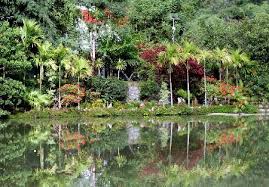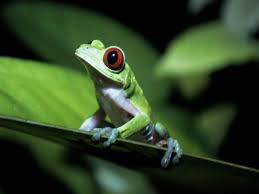Team members
 (LEADER)
(LEADER)
 (WRITER)
(WRITER)
 (Researcher)
(Researcher)
Overview
The tropical rainforest is earth's most complex biome in terms of both structure and species diversity. It occurs under optimal growing conditions: abundant precipitation and year round warmth. There is no annual rhythm to the forest; rather each species has evolved its own flowering and fruiting seasons. Sunlight is a major limiting factor. A variety of strategies have been successful in the struggle to reach light or to adapt to the low intensity of light beneath the canopy.
The tropical rain forest biome is one of the most productive areas on earth. More than half of the different kinds animals and plants in the world live in the tropical rain forests. The abundant sunlight, warm temperatures, and daily rain lead to a fast turnover of nutrients, and plant growth is rapid. This is a land without winter, so the growing season lasts all year. There are flowers and fruit all year round.
These forests have been in existence for between 70 million and 100 million years, so this biome is very old.The tropical rain forest biome is one of the most productive areas on earth. More than half of the different kinds animals and plants in the world live in the tropical rain forests. The abundant sunlight, warm temperatures, and daily rain lead to a fast turnover of nutrients, and plant growth is rapid. This is a land without winter, so the growing season lasts all year. There are flowers and fruit all year round.
These forests have been in existence for between 70 million and 100 million years, so this biome is very old.
HERE"S SOME PICTURES: click the link to see it!!!
pics.doc
Physical Factors
- The Tropical Rainforest is a forest of tall trees in a region of year-round warmth.An average of 50-260 inches(125-660cm) of rain falls yearly.The temperature of the tropical rainforest rarely gets higher 93 degree fahrenheit (34 degree celsius) or drops below 68 degree fahrenheit (20 degree celsius) ; average humidity is between 77 & 88 % ; rainfall is often more than 100 inches a year. There is usually a brief season of less rain.
- Tropical rainforests have some of the largest rivers in the world, like the Amazon, Madeira, Mekong, Negro, Orinoco, and Zaire (Congo), because of the tremendous amount of precipitation their watersheds receive. These mega-rivers are fed by countless smaller tributaries, streams, and creeks. For example, the Amazon alone has some 1,100 tributaries, 17 of which are over 1,000 miles long. Although large tropical rivers are fairly uniform in appearance and water composition, their tributaries vary greatly. Many tropical rivers and streams have extreme high and low water levels that occur at different parts of the year.
- Temperature is on average 20-25° C and varies little throughout the year: the average temperatures of the three warmest and three coldest months do not differ by more than 5 degrees.
- Precipitation is evenly distributed throughout the year, with annual rainfall exceeding 2000 mm.
- Soil is nutrient-poor and acidic. Decomposition is rapid and soils are subject to heavy leaching.
- Canopy in tropical forests is multilayered and continuous, allowing little light penetration.
- Flora is highly diverse: one square kilometer may contain as many as 100 different tree species. Trees are 25-35 m tall, with buttressed trunks and shallow roots, mostly evergreen, with large dark green leaves. Plants such as orchids, bromeliads, vines (lianas), ferns, mosses, and palms are present in tropical forests.
- Fauna include numerous birds, bats, small mammals, and insects.
- The tropical rainforests take in vast quantities of carbon dioxide (a poisonous gas which mammals exhale) and through the process of photosynthesis, converts it into clean, breathable air. In fact, the tropical rainforests are the single greatest terrestrial source of air that we breathe.
-
The rainforests extend in a discontinuous way over expanded territories; the presence of mountains, plateaus, lakes, marshes and rivers prevents that it covers all the equatorial zone. The virgin forest is located in Central and South America, Central Africa and in Malaysia and lndonesia. The landscape is similar in all those areas, but each one of them has their own characteristics.
The ground, that provides water and mineral salts are not fertile in the rainforest, since the organic matter quickly is disturbed by the heat and the humidity, and the nutrients are washed in intense rains. In addition, it remains humid, since the thick foliage absorbs almost all the light and it doesn't allow the passage of solar rays towards the interior. The visibility reaches about 20 meters
Classification of Living Organisms
The combination of heat and moisture makes the tropical rain forest the perfect environment for more then 15 million types of plants and animals. Some of the animals of the tropical rain forest are the jaguar, the anteater, lemur and many others, among the many plant species such as bamboo banana trees and rubber trees.
The Tropical Rainforest biome is the richest source of plant life in the whole entire earth, with temperatures around 70-90 degrees and lots of water supply, this makes this biome a perfect place for large amounts of plant life. In the Tropical Rainforest there is so much different and unique plants, that scientists don’t even know all of them. Here are just a few plants that are now commonly grown and sold to people across the world that originally came from the rainforest. Avocado, bananas, coffee, lemon, orange, peanut, peppers, and pineapples
Plants from the rain forest are very useful in many different uses around the world. Such as hundreds of different medical supplies, many foods (fruit etc.), timber
Producers:
The rain forest grows in three levels, the Canopy, which is the tallest level it has trees between 100 and 200 feet tall. The second level called the understory contains a mix of shrubs, ferns, palms, small trees and vines. The third and lowest level is the Forest floor where herbs, mosses and fungi grow.
A producer is an organism that makes it’s own food from light energy or chemical energy. Most green plants that are one-celled organisms like slime molds and bacteria are producers. Producers are the base of the food chain.

· Bamboo
· Banana Trees
· Rubber Trees
· Cassava
· Bromeliads
· Avocado
· Many tropical fruit trees such as lemon, orange etc.
· Air plants






